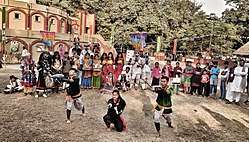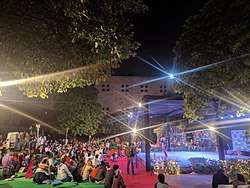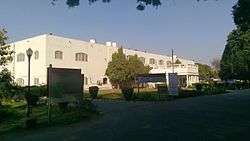Indira Gandhi National Centre for the Arts
Indira Gandhi National Centre for the Arts (IGNCA), New Delhi is a premier government-funded arts organization in India. It is an autonomous institute under the Union Ministry of Culture. It was established in the memory of Indian Prime Minister Indira Gandhi, with Kapila Vatsyayan as its founding director.[1]



History
The IGNCA was launched on 19 November 1985 by Prime Minister Shri Rajiv Gandhi at a function where the symbolism of the components was clearly articulated at different levels. The elements - fire, water, earth, sky and vegetation - were brought together. Five rocks from five major rivers - Sindhu (Indus), Ganga, Kaveri, Mahanadi and the Narmada (where the most ancient ammonite fossils are found) were composed into sculptural forms. These remain at the site as reminders of the antiquity of Indian culture and the sacredness of her rivers and rocks.
The Indira Gandhi National Centre for the Arts Trust was constituted and registered at New Delhi on 24 March 1987.
About
The Indira Gandhi National Centre for the Arts, established in memory of Indira Gandhi, is visualised as a centre encompassing the study and experience of all the arts—each form with its own integrity, yet within a dimension of mutual interdependence, interrelated with nature, social structure and cosmology.
Location
Indira Gandhi National Centre for the Arts
1, C. V. Mess, Janpath,
New Delhi - 110 001 (India)
Goals
Its official goals are:
- to serve as a major resource centre for Indian arts, especially written, oral and visual source materials
- to conduct research on the arts and humanities, and to publish reference works, glossaries, dictionaries and encyclopedias
- to establish a tribal and folk arts division with a core collection for conducting systematic scientific studies and live presentations
- to provide a forum for dialogue through performances, exhibitions, multi-media projections, conferences, seminars and workshops on traditional and contemporary Indian arts
- to foster dialogue between the arts and current ideas in philosophy, science and technology, with a view toward bridging the gap in intellectual understanding between modern sciences and arts and culture
- to evolve models of research programmes and arts administration pertinent to the Indian ethos
- to elucidate the formative and dynamic factors in the complex web of interactions between diverse social strata, communities and regions
- to interact with other national and international institutions
- to conduct related research in the arts, humanities and culture
Units
- Kalānidhi (Devanagari: कलानिधि) is a reference library on multimedia collections.[3]
- Kālakośa (कलाकोश) is the research and publication division, investigating the intellectual traditions in their dimensions of multi-layers and multi-disciplines.[4]
- Janapada Sampadā (जनपद संपदा), is the division engaged in lifestyle studies.[5] It has a programmatic character classified as Lifestyle Studies, Multi-media Presentation, Events, and Children's World, each with a number of subprograms.
- Kalādarśana (कलादर्शन) is the executive unit that transforms researches and studies emanating from the IGNCA into visible forms through exhibitions.[6]
- Cultural Informatics Laboratory (संस्कृतिका संयन्त्रिका संचार), where there are applied technology tools for cultural preservation and propagation.[7] Among its projects it is Kalāsampadā (कलासंपदा),[8] a digital repository of content and information integrated with a user-friendly interface, for encompassing and preserving the rare archival collections of the IGNCA.
- Sutrādhāra (सूत्राधार) is the administrative section, supporting and coordinating all the activities.[9] The Member Secretary is the Executive head of both academic and administrative divisions. It comprises Administration, Finance, Accounts, Services & Supplies and International Dialogue Unit.
- The Diaspora Cultural Resource Centre[10] aims to build up a cross-cultural inter disciplinary dialogue among Indians in India and the world and to catalyst cultural inputs in the development by drawing on Indian Diaspora.
Regional centres
- Southern Regional Centre, established in 2001, in Bangalore, aimed at intensifying the centre's studies on the southern region's art and cultural heritage.[11]
- Varanasi Regional Centre, established in 1998, mainly engaged in publication of Kalatattvakosa series, a lexicon of fundamental concepts of the Indian arts.[12]
References
- "About us". IGNCA Official website. Archived from the original on 6 January 2018. Retrieved 27 October 2011.
- "MoS Home Shri Kiren Rijiju to inaugurate three-day Kathakar: International Storytellers Festival tomorrow". pib.nic.in. Retrieved 21 April 2018.
- Kalānidhi
- Kālakośa
- Janapada Sampadā
- Kalādarśana
- Cultural Informatics Laboratory
- Kalāsampadā
- Sutrādhāra
- Diaspora Cultural Resource Centre
- IGNCA Southern Regional Centre Archived 2007-12-27 at the Wayback Machine
- IGNCA Varanasi Regional Centre